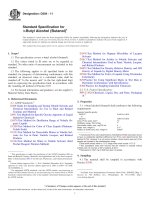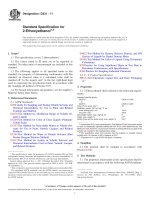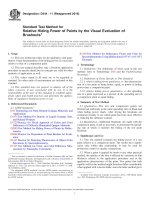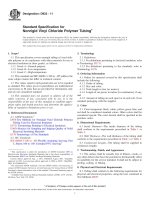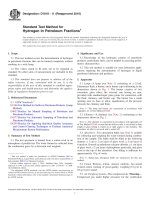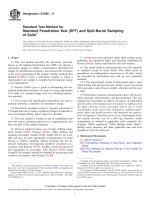Astm d 4944 11
Bạn đang xem bản rút gọn của tài liệu. Xem và tải ngay bản đầy đủ của tài liệu tại đây (224.03 KB, 6 trang )
Designation: D4944 − 11
Standard Test Method for
Field Determination of Water (Moisture) Content of Soil by
the Calcium Carbide Gas Pressure Tester 1
This standard is issued under the fixed designation D4944; the number immediately following the designation indicates the year of
original adoption or, in the case of revision, the year of last revision. A number in parentheses indicates the year of last reapproval. A
superscript epsilon (´) indicates an editorial change since the last revision or reapproval.
1.5 The values stated in SI units are to be regarded as
standard. No other units of measurement are included in this
standard.
1.5.1 Cited sieve sizes are the standard sieve sizes given in
Table 1 of Specification E11.
1. Scope*
1.1 This test method outlines procedures for determining the
water (moisture) content of soil by chemical reaction using
calcium carbide as a reagent to react with the available water
in the soil producing a gas. A measurement is made of the gas
pressure produced when a specified mass of wet or moist soil
is placed in a testing device with an appropriate volume of
reagent and mixed.
1.6 All observed and calculated values shall conform to the
guidelines for significant digits and rounding established in
Practice D6026 unless superseded by this standard.
1.6.1 The procedures used to specify how data are collected,
recorded or calculated in this standard are regarded as the
industry standard. In addition they are representative of the
significant digits that generally should be retained. The procedures used do not consider material variation, purpose for
obtaining the data, special purpose studies, or any considerations for the user’s objectives; it is common practice to
increase or reduce significant digits of reported data to be
commensurate with these considerations. It is beyond the scope
of this standard to consider significant digits used in analytical
methods for engineering design.
1.7 This standard does not purport to address all of the
safety concerns, if any, associated with its use. It is the
responsibility of the user of this standard to establish appropriate safety and health practices and determine the applicability of regulatory limitations prior to use. For specific
hazards statements, see Section 7.
1.2 This test method is not intended as a replacement for
Test Method D2216; but as a supplement when rapid results are
required, when testing is done in field locations, or where an
oven is not practical for use. Test Method D2216 is to be used
as the test method to compare for accuracy checks and
correction.
1.3 This test method is applicable for most soils. Calcium
carbide, used as a reagent, reacts with water as it is mixed with
the soil by shaking and agitating with the aid of steel balls in
the apparatus. To produce accurate results, the reagent must
react with all the water which is not chemically hydrated with
soil minerals or compounds in the soil. Some highly plastic
clay soils or other soils not friable enough to break up may not
produce representative results because some of the water may
be trapped inside soil clods or clumps which cannot come in
contact with the reagent. There may be some soils containing
certain compounds or chemicals that will react unpredictably
with the reagent and give erroneous results. Any such problem
will become evident as calibration or check tests with Test
Method D2216 are made. Some soils containing compounds or
minerals that dehydrate with heat (such as gypsum) which are
to have special temperature control with Test Method D2216
may not be affected (dehydrated) in this test method.
2. Referenced Documents
2.1 ASTM Standards:2
D653 Terminology Relating to Soil, Rock, and Contained
Fluids
D2216 Test Methods for Laboratory Determination of Water
(Moisture) Content of Soil and Rock by Mass
D3740 Practice for Minimum Requirements for Agencies
Engaged in Testing and/or Inspection of Soil and Rock as
Used in Engineering Design and Construction
D4753 Guide for Evaluating, Selecting, and Specifying Balances and Standard Masses for Use in Soil, Rock, and
1.4 This test method is limited to using calcium carbide
moisture test equipment made for 20 g, or larger, soil specimens and to testing soil which contains particles no larger than
the No. 4 Standard sieve size.
1
This test method is under the jurisdiction of ASTM Committee D18 on Soil and
Rock and is the direct responsibility of Subcommittee D18.08 on Special and
Construction Control Tests.
Current edition approved Nov. 1, 2011. Published December 2011. Originally
approved in 1989. Last previous edition approved in 2004 as D4944 – 04. DOI:
10.1520/D4944-11.
2
For referenced ASTM standards, visit the ASTM website, www.astm.org, or
contact ASTM Customer Service at For Annual Book of ASTM
Standards volume information, refer to the standard’s Document Summary page on
the ASTM website.
*A Summary of Changes section appears at the end of this standard
Copyright © ASTM International, 100 Barr Harbor Drive, PO Box C700, West Conshohocken, PA 19428-2959. United States
1
D4944 − 11
locations where it is not practical to install an oven or to
transport samples to an oven. This test method is used for these
occasions.
Construction Materials Testing
D6026 Practice for Using Significant Digits in Geotechnical
Data
E11 Specification for Woven Wire Test Sieve Cloth and Test
Sieves
E177 Practice for Use of the Terms Precision and Bias in
ASTM Test Methods
E691 Practice for Conducting an Interlaboratory Study to
Determine the Precision of a Test Method
5.2 The results of this test have been used for field control
of compacted embankments or other earth structures such as in
the determination of water content for control of soil moisture
and dry density within a specified range.
5.3 This test method requires specimens consisting of soil
having all particles smaller than the No. 4 sieve size.
3. Terminology
5.4 This test method may not be as accurate as other
accepted methods such as Test Method D2216. Inaccuracies
may result because specimens are too small to properly
represent the total soil, from clumps of soil not breaking up to
expose all the available water to the reagent and from other
inherent procedural, equipment or process inaccuracies.
Therefore, other methods may be more appropriate when
highly accurate results are required, or when the use of test
results is sensitive to minor variations in the values obtained.
3.1 Definitions—Definitions of terms used in this test
method can be found in Terminology D653.
4. Summary of Test Method
4.1 A measured volume of calcium carbide, in excess of that
needed to react with the water, is placed in the testing apparatus
along with two steel balls and a representative specimen of soil
having all particles smaller than the No. 4 sieve size and having
a mass equal to that specified by the manufacturer of the
instrument or equipment. The apparatus is shaken vigorously
in a rotating motion so the calcium carbide reagent can contact
all the available water in the soil. Acetylene gas is produced
proportionally to the amount of available water present. The
apparent water content is read from a pressure gauge on the
apparatus calibrated to read in percent water content for the
mass of soil specified.
NOTE 1—The quality of the result produced by this standard is
dependent on the competence of the personnel performing it, and the
suitability of the equipment and facilities used. Agencies that meet the
criteria of Practice D3740 are generally considered capable of competent
and objective testing/sampling/inspection. Users of this standard are
cautioned that compliance with Practice D3740 does not in itself ensure
reliable results. Reliable results depend on many factors; Practice D3740
provides a means of evaluating some of those factors.
6. Apparatus
4.2 A calibration curve is developed for each instrument and
each soil type by plotting the pressure gauge reading and the
water content determined from Test Method D2216 using
representative specimens of the soil. The calibration curve is
used to determine a corrected water content value for subsequent tests on the same type of soil.
6.1 Calcium Carbide Pressure Tester Set Including:
6.1.1 Testing chamber with attached pressure gauge.
6.1.2 A set of tared manual balances or portable electronic
balance meeting the requirements of a GP2 of Specification
D4753.
NOTE 2—Testers that use a smaller mass are available, but are
considered too inaccurate for this standard. The testing chamber with
pressure gauge and the balances are calibrated as a set (see Section 8). A
typical apparatus is shown in Fig. 1.
5. Significance and Use
5.1 The water content of soil is used throughout geotechnical engineering practice, both in the laboratory and in the field.
Results are sometimes needed within a short time period and in
6.1.3 Carrying case.
FIG. 1 Typical Calcium Carbide Gas Pressure Test Apparatus for Water Content of Soil
FIG. 1a (left) Apparatus
Set with Manual Tared Balance
FIG. 1b (right) Apparatus Set with Portable Electronic Balance
2
D4944 − 11
6.1.4 Typical apparatus configurations are shown in Fig. 1.
8. Calibration
6.2 Small Scoop, for measuring reagent.
8.1 The manufacturer-supplied equipment set, including the
testing chamber with attached gauge and the balance scales, are
calibrated as a unit and paired together for the testing procedure.
6.3 Two Steel Balls, (manufacturer supplied).
6.4 Brush and Cloth, for cleaning and other incidental
items.
8.2 Calibration curves must be developed for each equipment set using the general soil types to be tested and the
expected water content range of the soil. As new materials are
introduced, further calibration is needed to extend the curve
data for the specific instrument. If tests are made over a long
period of time on the same soil, a new calibration curve should
be made periodically, not exceeding 12 months. Before a new
batch of reagent is used for testing, two checkpoints shall be
compared to the existing curve. If variation is exceeded by
more than 1.0 % of moisture, a new calibration curve shall be
established.
6.5 Sieve, No. 4 (4.75 mm), conforming to the requirements
of Specification E11.
6.6 Calcium Carbide Reagent, finely pulverized, of a grade
that will readily combine with the available sample moisture
and is capable of producing acetylene gas in the amount of at
least 0.14 cubic meters/kg (2.25 cu ft/lb). It is best to purchase
calcium carbide in small containers with air tight replaceable
lids, to store it in a dry place, to keep the lid on the container
at all times except when measuring out a portion for use in a
test, and to use a complete container before opening a new one.
Calcium carbide quality will deteriorate with time after it
becomes exposed to the atmosphere or any source of moisture.
Periodic purchase of a new supply is recommended.
8.3 Calibration curves are produced by selecting several
samples representing the range of soil materials to be tested
and having a relatively wide range of water content. Each
sample is carefully divided into two specimens by quartering
procedures or use of a sample splitter. Taking care to not lose
any moisture, one specimen is tested in accordance with the
procedure of this test method (see 10.1 – 10.6) without using a
calibration curve, and the other specimen is tested in accordance with Test Method D2216.
6.7 Miscellaneous Clothing or Safety Equipment, such as
goggles to protect the operator (see 7.2).
6.8 Equipment, as listed in Test Method D2216, for performing comparison tests to make calibration curves.
NOTE 3—Calibration kits are available from manufacturers for testing
gasket leakage and for calibrating the gauge. Periodic checks for gasket
leakage are recommended. The gasket should be changed when leakage is
suspected. Gauge calibration problems can usually be detected as the
instrument calibration curves are made (see Section 8). When the gauge
needs adjusting, any good quality calibrating gauge can be used.
8.4 The results of the oven dry water content determined by
Test Method D2216 from all the selected samples are plotted
versus the gauge reading from the calcium carbide tester for the
corresponding test specimen pair. A best fit curve is plotted
through the points to form a calibration curve for each soil
type. Comparisons should be relatively consistent. A wide
scatter in data indicates that either this test method or Test
Method D2216 is not applicable to the soil or conditions. Fig.
2 shows a typical calibration curve.
7. Safety Hazards
7.1 When combined with water, the calcium carbide reagent
produces a highly flammable or explosive acetylene gas.
Testing should not be carried out in confined spaces or in the
vicinity of an open flame, embers or other source of heat that
can cause combustion. Care should be exercised when releasing the gas from the apparatus to direct it away from the body.
Lighted cigarettes, hot objects or open flames are extremely
dangerous in the area of testing.
8.5 A comparison of this test method with Test Method
D2216 for a given soil can be made by using the calibration
curve. Points that plot off the curve indicate deviations.
Standard and maximum deviations can be determined if
desired.
7.2 As an added precaution, the operator should use a dust
mask, clothing with long sleeves, gloves and goggles to keep
the reagent from irritating the eyes, respiratory system, or
hands and arms.
9. Sampling
9.1 For water content testing being done in conjunction with
another method (such as Test Method D2216), the requirements for sample and test specimen selection and handling in
the other standard shall govern.
7.3 Attempts to test excessively wet soils or improper use of
the equipment, such as adding water to the testing chamber,
could cause pressures to exceed the safe level for the apparatus.
This may cause damage to the equipment and an unsafe
condition for the operator.
9.2 Equipment limitations require the use of specimens
smaller than is recommended to properly represent the total
soil. Extra care must be exercised to select specimens that are
representative of the soil.
7.4 Care should be taken not to dispose or place a significant
amount of the calcium carbide reagent where it may contact
water because it will produce an explosive gas.
9.3 Specimens are to contain only soil particles smaller than
the No. 4 Standard sieve size.
7.5 Calcium carbide is classified as a hazardous material
and the user should conform to appropriate regulations regarding the use, storage, handling and transportation of calcium
carbide.
10. Procedure
10.1 Remove the cap from the testing chamber of the
apparatus and place the recommended amount of calcium
carbide reagent along with the two steel balls into the testing
3
D4944 − 11
FIG. 2 Typical Calibration Curve
impact a grinding effect on the soil and reagent. This motion
also prevents the steel balls from striking the orifice that leads
to the pressure gauge. Shake the apparatus for at least 1 min for
sands, increasing the time for silts, and up to 3 min for clays.
Some highly plastic clay soils may take more than 3 min.
Periodically check the progress of the needle on the pressure
gauge dial. Allow time for the needle to stabilize as the heat
from the chemical reaction is dissipated.
chamber. Most equipment built to test 20-g samples requires
approximately 22 g of reagent (measured using the supplied
scoop, which is filled two times).
10.2 Use either the manual or portable electronic balance to
obtain a specimen of soil that has a mass recommended for the
equipment and contains particles smaller than the No. 4 sieve
size. Determine the mass to the nearest 0.1 g. One-half
specimen size should be used when the water content is
expected to exceed the limits of the gauge on the gas pressure
chamber or when it actually reaches or exceeds the gauge limit
in any test (see 10.6).
10.6 When the pressure gauge dial needle stops moving,
read the dial while holding the apparatus in the horizontal
position. If the dial goes to the limit of the gauge, 10.1 – 10.6
should be repeated using a new specimen having a mass half as
large as the recommended specimen. When a half size specimen is used, the final dial reading is multiplied by two for use
with the calibration curve.
10.3 Place the soil specimen in the testing chamber cap;
then, with the apparatus in the horizontal position, insert the
cap in the testing chamber and tighten the clamp to seal the cap
to the unit. Take care that no calcium carbide comes in contact
with the soil until a complete seal is achieved.
10.7 Record the final pressure gauge dial reading and use
the appropriate calibration curve to determine the corrected
water content in percent of dry mass of soil and record.
NOTE 4—The soil specimen may be placed in the chamber with the
calcium carbide in the cap if desired.
10.4 Raise the apparatus to the vertical (upright) position so
that the contents of the cap fall into the testing chamber. Strike
the side of the apparatus with an open hand to assure that all the
material falls out of the cap.
10.8 With the cap of the testing chamber pointed away from
the operator, slowly release the gas pressure (see Section 7).
Empty the chamber and examine the specimen for lumps. If the
material is not completely pulverized, the test should be
repeated using a new specimen.
10.5 Shake the apparatus vigorously with a rotating motion
so that the steel balls roll around the inside circumference and
4
D4944 − 11
10.9 Clean the testing chamber and cap with a brush or cloth
and allow the apparatus to cool before performing another test.
Repeated tests can cause the apparatus to heat up which will
affect the results of the test. The apparatus should be at about
the same temperature as it was during calibration (determined
by touch). This may require warming the instrument up to
calibration temperature before use when the temperature is
cold.
12.1.1 Repeatability Limit (r)—Two test results obtained
within one laboratory shall be judged not equivalent if they
differ by more than the “r” value for that material; “r” is the
interval representing the critical difference between two test
results for the same material, obtained by the same operator
using the same equipment on the same day in the same
laboratory.
12.1.1.1 Repeatability limits are listed in Table 1 below.
12.1.2 Reproducibility Limit (R)—Two test results shall be
judged not equivalent if they differ by more than the “R” value
for that material; “R” is the interval representing the critical
difference between two test results for the same material,
obtained by different operators using different equipment in
different laboratories.
12.1.2.1 Reproducibility limits are listed in Table 1 below.
12.1.3 The above terms (repeatability limit and reproducibility limit) are used as specified in Practice E177.
12.1.4 Any judgment in accordance with statements 12.1.1
and 12.1.2 would have an approximate 95 % probability of
being correct.
10.10 Discard the specimen where it will not contact water
and produce an explosive gas. It is recommended that the
specimen soil not be used for further testing as it is contaminated with the reagent.
11. Report:Data Sheet(s)/Form(s)
11.1 The Data Sheet is to include the following information:
11.1.1 Test number assigned and identification of the
sample by location (segment of the project, station, elevation,
zone or feature) and by classification or description of the
material.
11.1.2 Apparatus identification by number.
11.1.3 Specimen mass and final pressure gauge dial reading
from the apparatus, and
11.1.4 Water content of the sample (from the calibration
curve) to the nearest 1 %.
12.2 Bias—At the time of the study, the calculated water
content was also determined by oven drying in accordance with
Test Method D2216, and a relative bias for each water content
is reported in Table 1.
12. Precision and Bias
12.3 The precision statement was determined through statistical examination of 78 test results, conducted by eight
individuals, for three water contents. The test material was a
medium to fine sand with about 5 % of non-plastic fines. The
test material was prepared at three target water contents:
Target water content A: 8 %
Target water content B: 12.5 %
Target water content C: 16.5 %
12.1 The precision of this test method is based on an
intralaboratory study of Test Method D4944 conducted in 2007
by the Florida Department of Transportation. Eight technicians
convened at a single location to participate in this study,
analyzing one material at three different water contents. Each
“test result” reported represents an individual determination
and all participants reported three to five replicate test results
for each water content. Practice E691 was followed for the
design and analysis of the data; the details are given in ASTM
Research Report RR:D18-1020.3
13. Keywords
13.1 acceptance test; calcium carbide; gas pressure; moisture content; pressure-measuring instrument; quick test; soil
moisture; soil water content; water content
3
Supporting data have been filed at ASTM International Headquarters and may
be obtained by requesting Research Report RR:D18-1020.
TABLE 1 Water Moisture Content of Soil (%)
Target
Water
Content
AverageA
χ¯
A
B
C
8.7
13.2
17.5
Repeatability
Standard
Deviation
Reproducibility
Standard
Deviation
Repeatability
Limit
Reproducibility
Limit
sr
sR
r
R
0.22
0.23
0.60
0.24
0.39
0.94
0.61
0.63
1.67
0.68
1.10
2.62
A
The average of the laboratories’ calculated averages.
The average response from eight laboratories.
B
5
Calculated
Water
ContentB
Chart
Moisture Bias
as Compared to
the Calculated
Water Content (%)
8.1
12.8
16.5
106.9
103.4
105.8
D4944 − 11
SUMMARY OF CHANGES
Committee D18 has identified the location of selected changes to this test method since the last issue,
D4944–04, that may impact the use of this test method. (Approved November 1, 2011)
(3) Revised Section 7 to warn user that calcium carbide is
classified as a hazardous material.
(4) Heavily revised Section 12 Precision and Bias, including
new Table 1.
(1) Revised Scope to include requirements for significant
digits.
(2) Revised Section 6 to permit the use of portable electronic
balances
ASTM International takes no position respecting the validity of any patent rights asserted in connection with any item mentioned
in this standard. Users of this standard are expressly advised that determination of the validity of any such patent rights, and the risk
of infringement of such rights, are entirely their own responsibility.
This standard is subject to revision at any time by the responsible technical committee and must be reviewed every five years and
if not revised, either reapproved or withdrawn. Your comments are invited either for revision of this standard or for additional standards
and should be addressed to ASTM International Headquarters. Your comments will receive careful consideration at a meeting of the
responsible technical committee, which you may attend. If you feel that your comments have not received a fair hearing you should
make your views known to the ASTM Committee on Standards, at the address shown below.
This standard is copyrighted by ASTM International, 100 Barr Harbor Drive, PO Box C700, West Conshohocken, PA 19428-2959,
United States. Individual reprints (single or multiple copies) of this standard may be obtained by contacting ASTM at the above
address or at 610-832-9585 (phone), 610-832-9555 (fax), or (e-mail); or through the ASTM website
(www.astm.org). Permission rights to photocopy the standard may also be secured from the Copyright Clearance Center, 222
Rosewood Drive, Danvers, MA 01923, Tel: (978) 646-2600; />
6

